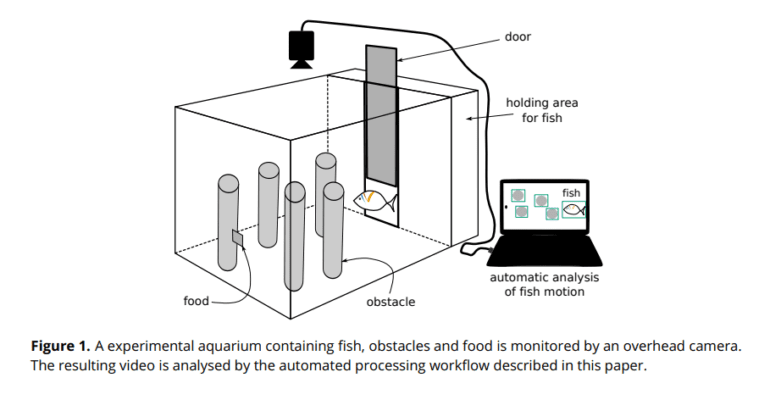TL;DR:
- Oxford researchers develop advanced deep learning-based software for precise fish tracking.
- Existing open-source tracking tools lack accuracy in diverse conditions.
- The hybrid approach combines deep learning and traditional computer vision techniques.
- Adaptive object detection with deep learning ensures accurate tracking in complex environments.
- Optical flow computation aids in overcoming appearance changes and occlusions.
- The method achieves a remarkable 97% alignment between computed and manual fish trajectories.
- Released software, dataset, and tutorial under a Creative Commons license to support the scientific community.
- Adapting to complex scenarios or multiple animals may require further refinement.
Main AI News:
The world of behavioral studies has seen a profound transformation thanks to automated animal tracking software. Its applications, particularly in monitoring laboratory creatures like aquarium fish, have become pivotal across various fields, including neuroscience, medicine, and biomechanics. Despite remarkable advancements, the existing array of open-source tracking tools often falls short when it comes to precision in diverse conditions, especially in the face of obstacles or complex environments.
Commonly utilized tracking solutions rely on techniques such as background subtraction or blob detection. While effective in controlled settings, these methods encounter significant limitations in natural environments or aquariums due to issues like reflections, ripples, and dynamic backgrounds. Even specialized software tailored for specific fish models, such as zebrafish, may excel under typical conditions but struggle in the face of the method’s inherent limitations.
Addressing these challenges head-on, a team of researchers based in the UK has introduced a groundbreaking hybrid approach. They’ve seamlessly merged deep learning with traditional computer vision techniques to elevate the accuracy of fish tracking in complex experimental setups.
Unlike conventional methods like background subtraction or blob detection, this novel approach champions adaptive object detection using deep learning. This innovation enables the precise tracking of fish, even amidst challenging conditions with varying backgrounds, occlusions, or deformations. By combining optical flow computation with object detection and tracking, this method guarantees robustness in the face of changes in the fish’s appearance or obstructions caused by obstacles. It provides pinpoint trajectory information, a feat that often eludes basic methods like background subtraction or blob detection in complex conditions.
This trailblazing approach combines deep learning’s adaptability with classical vision’s precision in centroid tracking. The result? A more robust solution for monitoring fish behavior in environments that have traditionally posed significant challenges.
The researchers outline their pioneering method in a comprehensive paper focused on analyzing Picasso triggerfish behavior through video processing in controlled tank settings. Their arsenal includes a GoPro Hero 5 camera, as well as advanced tools like EfficientDet and optical flow techniques.
The heart of the deep learning component involves object detection and tracking. Specifically, the paper harnesses a deep-learning-based object detector (EfficientDet) to identify both Picasso triggerfish and cylindrical obstacles within the video frames. This detector undergoes specialized training to accurately detect these specific objects within the video data.
Conversely, traditional computer vision techniques take center stage in the tracking process. The authors employ classical optical flow estimation between consecutive frames, a tried-and-true method in the realm of computer vision. This approach computes the fish’s trajectory and movement, enabling the accurate identification of fish trajectories amidst obstacles. By leveraging optical flow between consecutive frames, the researchers gain insights into how obstacles impact fish behavior.
The initial stages involved manual annotations in the videos, which were used to train the deep-learning object detector. An object tracker filled detection gaps by making use of nearby high-confidence identifications.
One of the critical elements in their method was the identification of gates and areas between obstacles where fish move. They employed Voronoi cell methods for gate identification, even introducing imaginary obstacles for tank boundary gates.
Despite the challenges posed by factors such as partial occlusion and the proximity of obstacles, this method achieved an impressive 97% alignment between computed and manual fish trajectories. In a commendable gesture, the researchers have released their software, dataset, and tutorial under a Creative Commons license, thus bolstering the broader scientific community’s ability to harness computer vision tools for animal tracking.
However, it’s worth noting that adapting this method to even more complex scenarios or multiple animals may necessitate further refinement. Challenges like partial occlusion and intricate environments remain factors that warrant ongoing consideration.
Conclusion:
The development of this innovative deep learning-powered fish tracking software marks a significant advancement in behavioral studies. Its precision and adaptability in complex environments offer promising opportunities for research and applications across various industries, potentially leading to increased demand for advanced tracking solutions in the market.

